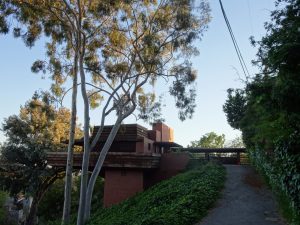
In times of great changes in the 1930s, driven by internationalization and industrialization, Frank Lloyd Wright (1867-1959) conceived the ‘Usonian Home’ (as for ‘United States-ian’). This era was dominated by interest in the technical side of structural solutions for architecture and cantilevering. The idea of the Usonian House concept was to build typically small, single-story housings which should bring modern architecture to the American middle-class. According to Wright, the nation’s greatest achievement was the formation of a broad middle-class. He believed that his Usonian houses, characterized by an open plan and ‘native’ materials like brick, stone and wood, would be the ideal model for simple, healthy and especially affordable dwellings for the common man. The Usonian houses have certain features in common: They are often L-shaped and equipped with solar heating and natural cooling. Furthermore, they often display overhanging roofs or balconies as well as a natural lighting through clerestory windows.

The Sturges Residence was, like Wright later said, ‘one of the simplest things we have done and one of the best’ regarding the Usonian House idea. The story of the George Sturges Residence began in 1938, when the engineer George Sturges and his wife Selma read the magazine ‘Architectural Forum’ whose January issue discussed Frank Lloyd Wright’s work. They were particularly interested in the low-cost houses, including the plan of the Jacobs Residence in Madison, Wisconsin. The Jacobs Residence is considered by most to be the first Usonian house. For the future home of Herbert and Katherine Jacobs Wright conceived a modest single-story structure measuring 140 m2 inside. The exterior appears in a combination of red brick, horizontal wooden boarding and glass doors citing the Prairie school that is usually marked by the integration with the landscape through horizontal lines, natural materials like brick or wood and flat or hipped roofs.
George and Selma Sturges decided to send Wright a letter of inquiry, and within a few months the designs for their future home were finished. Wright built the house in 1939 with the help of his apprentice John Lautner, who later became a renowned architect himself. The George Sturges Residence is the only example of a Usonian house in Los Angeles and is located in the Brentwood Heights neighbourhood of Brentwood. With a living space of about 110 m², the house is rather small, but well organized. Featuring a rectangular ground plan the living room with a dining area takes about one third of the living space. Two bedrooms, a kitchen, a bathroom and a small storage room take the two other thirds. A cantilevered terrace extends the space broadly, since the terrace circuits almost the whole sphere. The balcony emphasizes the dramatically situated house, since it seems to be soaring over the hillside. In combination with the panoramic deck on top of the house the long horizontal lines of the terrace give the building the look of a ship or an aircraft in motion which symbolizes the then-fascination with speed and machines.
Wright chose concrete, steel, brick and redwood as materials. The wooden siding and the wooden trellis hanging over the terrace are remnants of Wright’s Prairie style period of the early 20th century, noticeable also in the Jacobs Residence. The Sturges house’s interior is dominated by redwood walls, including the ceiling leading to nautical associations, too.
Apart from creating an affordable and fitting house for the middle-class, it was Wright’s aim to establish the features of industrialization on the construction site. He believed that the use of machines should transform architecture. He recommended the full use of the new technologies, but at the same moment he rejected the idea of machinistic aesthetics renouncing pure concrete surfaces or steel frames. Instead, he concentrated on the native materials like wood or brick with warm tints emanating homely feelings.
Elena Schmidt
All pictures are taken by the author.
Sources:
Twombly, Robert C.: Frank Lloyd Wright. His Life and his Architecture, New York 1971.
Zevi, Bruno: Frank Lloyd Wright, Zürich 1981.
http://fortune.com/2016/02/04/frank-lloyd-wright-sturges-house/
https://la-confidential-magazine.com/frank-lloyd-wrights-sturges-house-goes-up-for-auction
http://www.lasavvytours.com/georgesturgeshouse.htm
https://lamodern.com/frank-lloyd-wright-sturges-residence/frank-lloyd-wright-and-the-making-of-the-george-d-sturges-residence/
